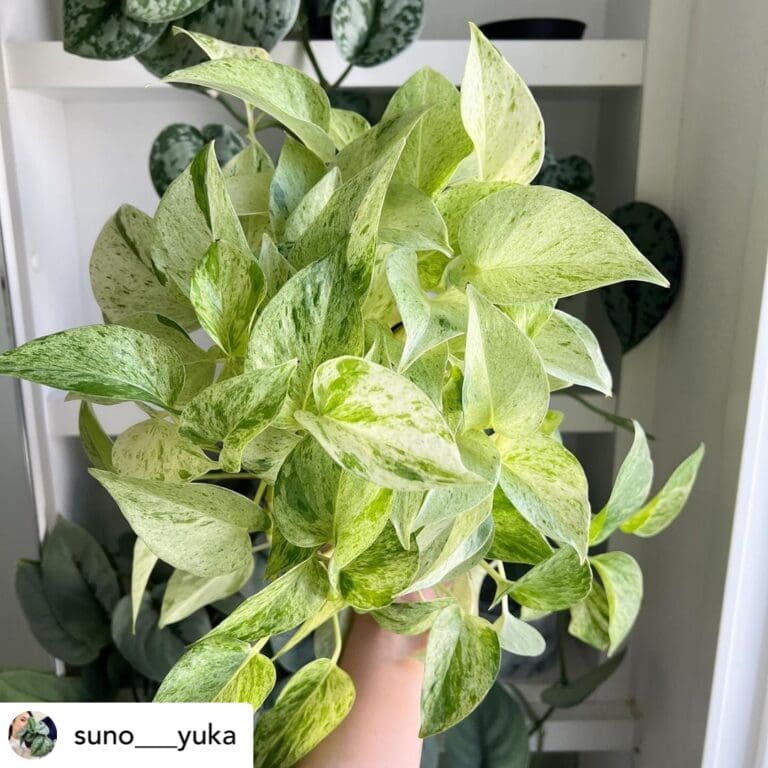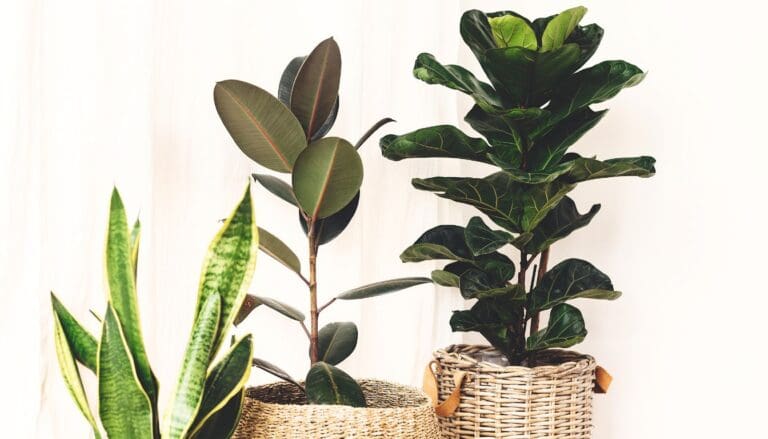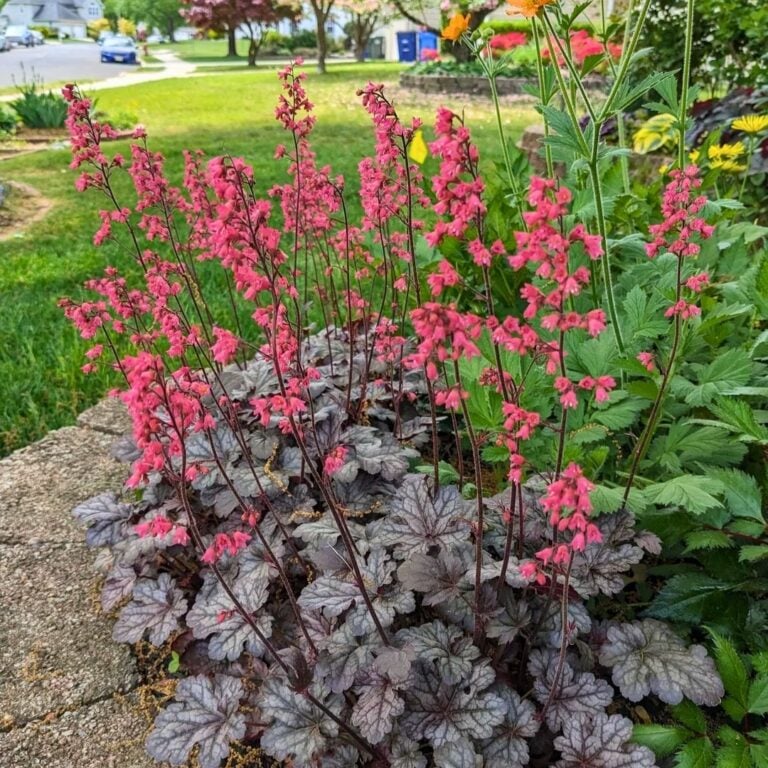19 Beautiful Plants You Can Grow In Just Water (No Soil Needed!)
Bringing nature indoors doesn’t have to be messy or complicated. Some plants actually thrive just in water, and honestly, they look amazing in a simple glass jar or vase.
You can grow vibrant, healthy plants using only water and a few simple steps.
It’s a fuss-free way to add some green to any spot—your desk, kitchen counter, or even a tiny windowsill.
I’ll share which plants really do well in water and how to keep them looking fresh all year. It’s easier than you might think.
Please note: Simplify Plants is reader-supported. As an Amazon Associate, I earn from qualifying purchases made by our readers with no extra cost added to you all! Some links in the post are affiliate links and I get a commission from purchases made through links in the post.
1) Pothos

I can’t get enough of Pothos. It’s just so forgiving and easy to grow in water, even if you’re not a plant expert.
I usually snip a healthy stem with a couple of leaves and a node or two. Drop it into a clear glass jar with fresh water, and you’ll see roots in a week or two.
I keep it somewhere with bright, indirect light. Too much sun just fries the leaves, so I avoid putting it right next to the window.
Every week or so, I swap out the water and rinse the jar. It helps prevent algae and keeps things looking clean.
What’s great is how Pothos thrives even if I forget about it for a while. Low light? Missed a water change? It’s usually fine.
The leaves stay shiny and green. The vines can really trail, which looks gorgeous on a shelf—or dangling from a jar.
If I want a bushier plant, I just add more cuttings to the same jar. They all root together and look super lush.
Pothos is perfect for beginners. It’s simple, tough, and always looks good.
2) Lucky Bamboo

Lucky Bamboo is another favorite. It’s so easy—just water, a clear glass container, and you’re set. No soil, no mess.
I use pebbles in the vase to keep the stalks upright. The roots stay submerged, but I don’t let the stems go too deep. I change the water every week so it doesn’t get funky.
It likes bright, indirect light. I don’t put it in the sun, since that can burn the leaves. If the leaves start turning yellow, it’s usually either too much light or the water’s dirty.
What’s fun is you can shape Lucky Bamboo. Some stalks twist, others grow straight—depends how you arrange them and play with the light.
I stick to filtered or distilled water because tap water sometimes has chemicals that aren’t great for the plant. Once a month, I rinse the vase and pebbles so nothing gets slimy.
Lucky Bamboo barely needs fertilizer, but I’ll add a drop of liquid plant food every few months. It helps keep the leaves green.
I like giving Lucky Bamboo as a gift. It’s easy, looks cool, and people say it brings good luck. Whether it’s on a desk or windowsill, it just adds a calm vibe.
3) Spider Plant

The Spider Plant is just so chill. It’s low-maintenance and its long green-and-white leaves brighten up any spot.
I snip off a plantlet and put it in a glass of water—roots pop up in no time. The base of the plantlet needs to touch the water, but I keep the leaves dry.
I change the water every few days. Fresh water helps prevent rot and keeps the roots healthy.
A clear glass makes it easy to see if the water’s low or cloudy. I keep my Spider Plant near a sunny window, but not in direct sunlight—those leaves can burn.
It grows fast, and soon I have new baby plants to share or start elsewhere. Even if I slack off on water changes, it bounces back. If you want a simple green plant that just works, this one’s a winner.
4) Philodendron Brasil
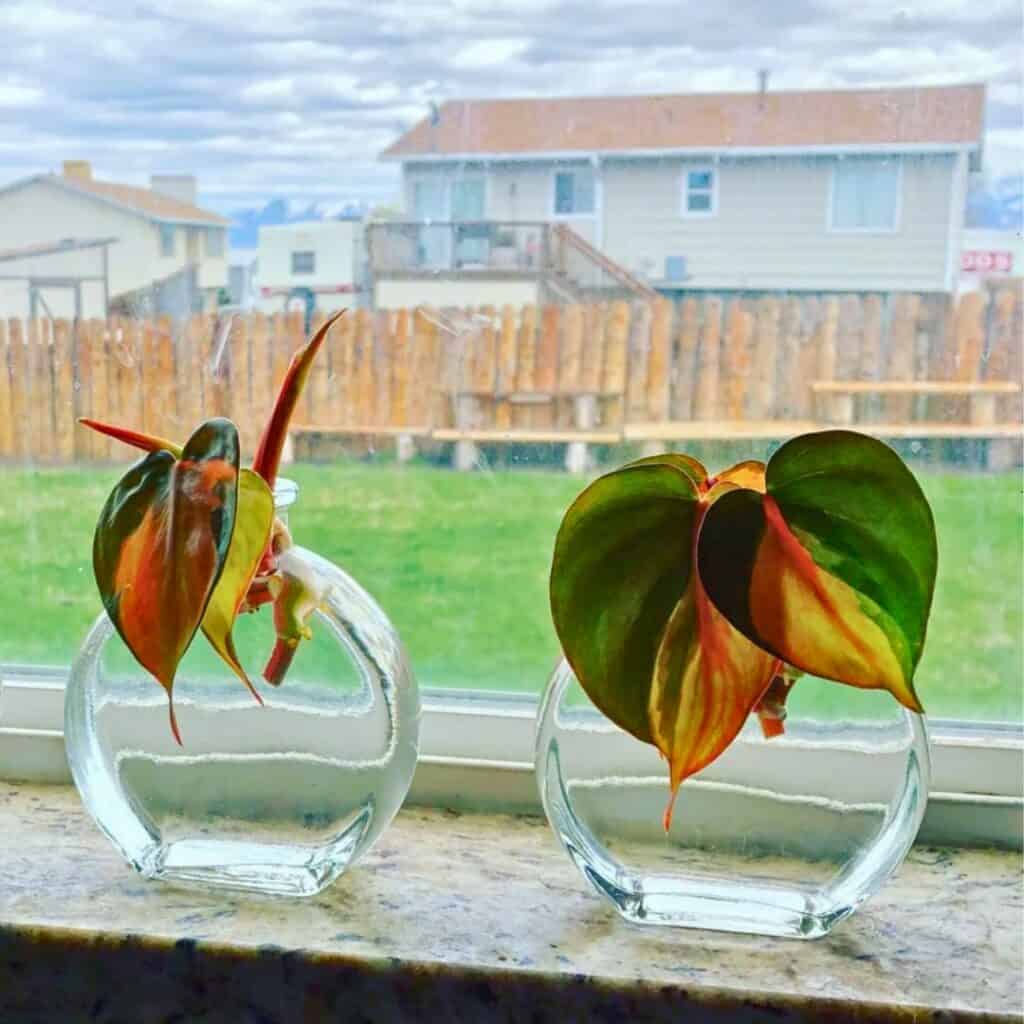
Philodendron Brasil is a show-off with its heart-shaped leaves streaked in green and yellow. It’s really easy to grow in water—almost too easy.
I take a cutting with a few nodes and drop it into a glass of clean water. Roots show up pretty quickly, and it’s actually fun to watch them grow.
It likes bright, indirect light. Too much sun fades the yellow, but too little and it just stops growing. I keep mine near a window where it gets gentle daylight.
I change the water every week or so. Clean water keeps the roots from rotting and the leaves happy.
The Philodendron Brasil is easygoing about temperature and doesn’t need much fuss. I just make sure the roots are covered and the jar stays clean.
Sometimes, when the roots get long, I’ll move it to soil, but honestly, it can live in water for ages. If you’re after a low-maintenance indoor plant, this one’s a solid pick.
Clear vases are my go-to so I can see the roots. It’s oddly satisfying, and it makes checking the water easy.
If I see leaves drooping, I just swap the water or move it to better light. It perks up pretty fast.
It’s one of those plants I love sharing. Just snip, stick it in water, and gift it when it roots. Simple, pretty, and great for plant newbies.
5) Chinese Evergreen
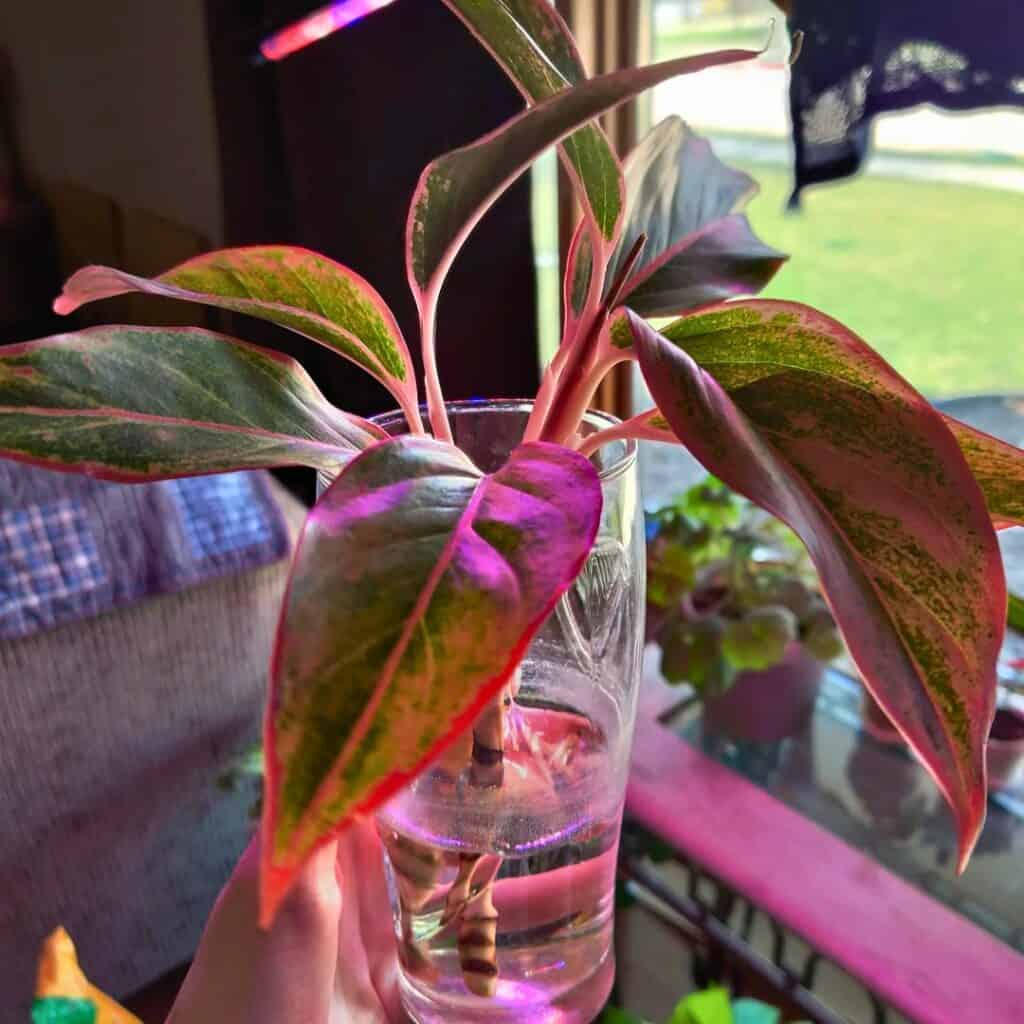
Chinese Evergreen is a classic. It’s easy to grow in water and always looks good—those glossy leaves just pop.
I cut a healthy stem below a node and drop it into a jar of clean water. The nodes stay underwater since that’s where the roots sprout.
I keep it in a bright spot with indirect sunlight. Once a week, I change the water so it stays clear and fresh.
When the roots are a few inches long, I know it’s happy. If the water gets cloudy, I rinse the jar and refill it.
This plant grows slowly in water, but it doesn’t mind. Sometimes I’ll add a drop of liquid fertilizer every few weeks for a little boost.
It needs almost no attention, which is perfect for busy folks. I like mine on the desk or kitchen counter—just a little spot of green, no soil drama.
6) English Ivy
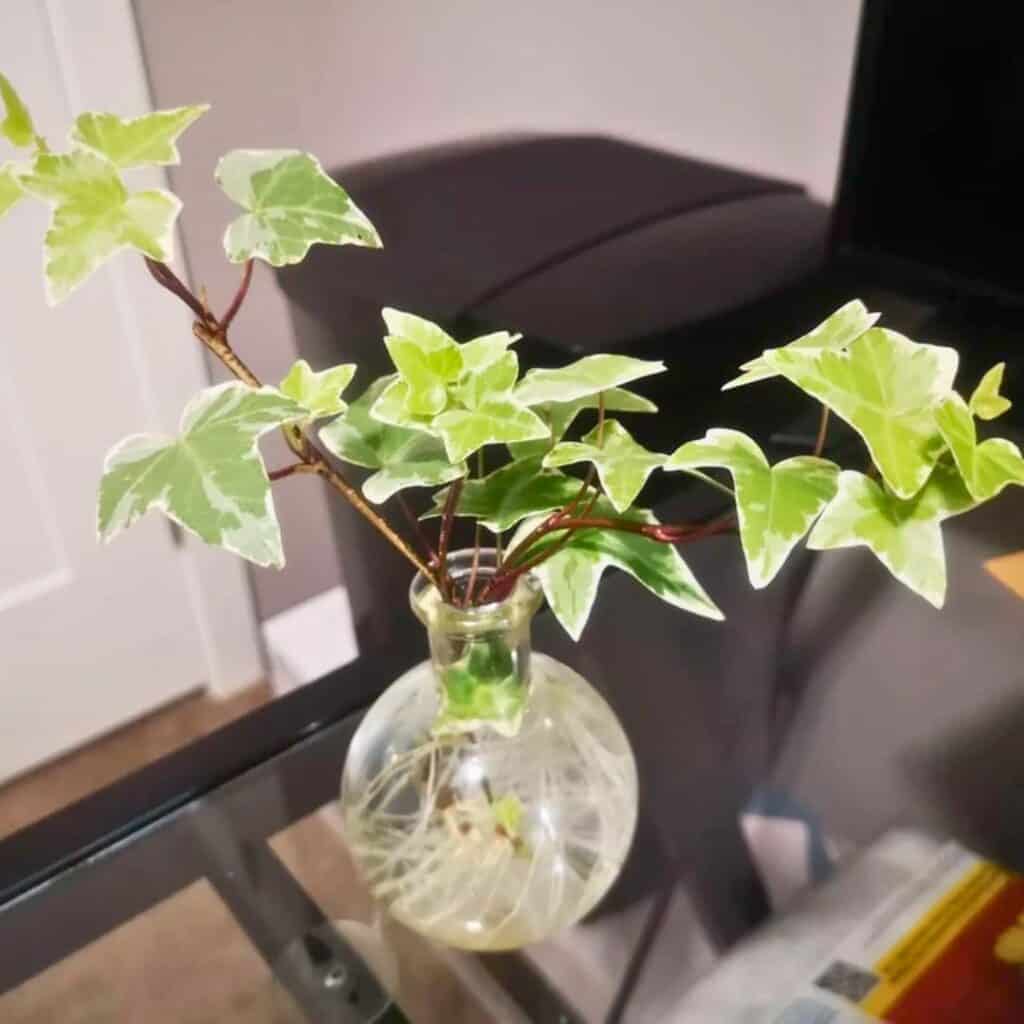
English Ivy is a breeze to grow in water. The vines look great trailing down from a shelf, and the leaves stay green all year.
I snip a healthy 4–6 inch stem, take off the lower leaves, and put it in a clear jar with fresh water. The leaves don’t touch the water, so they don’t rot.
I set the jar in bright, indirect light—near a window but not in the sun. I change the water once a week to keep algae away.
Roots usually show up in a couple weeks. Once they’re a few inches long, the ivy just keeps going. I trim the vines sometimes to keep them neat or to start new cuttings.
English Ivy likes cooler indoor temps, which is nice for most homes. Plus, it helps freshen the air—not bad, right?
If I spot yellow leaves, I check the light and water. Usually, a quick fix gets it back on track.
I love the classic look. Glass bottles or hanging jars show off the roots, and it adds a simple, natural vibe to any room.
7) Peace Lily

Peace Lilies just look so elegant, especially in water. Their glossy green leaves and white blooms really brighten up a space.
I cut a healthy stem below a leaf node and put it in a glass jar or vase. The roots stay underwater, but the leaves stay dry, which helps prevent rot.
I use clean, room‑temperature water and change it weekly. Fresh water gives the roots what they need and keeps algae away.
Peace Lilies like bright, indirect light. I keep mine close to a window, but not in direct sun. If the leaves droop, it’s usually a sign it needs more light or fresher water.
Every few weeks, I’ll add a tiny drop of liquid fertilizer. Too much can hurt the roots, so I keep it light.
It doesn’t grow as fast in water as in soil, but it stays lush and green. I love how little effort it takes for such a peaceful look.
Watching new roots in clear water is surprisingly rewarding. It’s a nice reminder that simple care goes a long way.
8) Arrowhead Plant

The Arrowhead Plant stays fresh and full even just in water. Those arrow-shaped leaves—green, cream, sometimes even pink—really stand out.
I snip a healthy stem below a node and drop it into a glass jar of clean water. The nodes have to be underwater for roots to grow.
I change the water about once a week to keep things clear and odor-free. Using filtered or room-temperature water seems to keep the roots looking their best.
It likes bright, indirect light, so I keep it near a window but out of the sun. Too much sun just fades the leaves.
The Arrowhead Plant grows faster in warm rooms. If the stems get too long, I trim them back—makes the plant bushier and encourages new growth.
Sometimes I’ll put a few cuttings together in one jar for a fuller look. The mix of colors and shapes makes a fun, lively display.
Honestly, it’s one of the easiest houseplants I’ve tried. Forgiving, low-maintenance, and it looks great in water for months.
9) Coleus
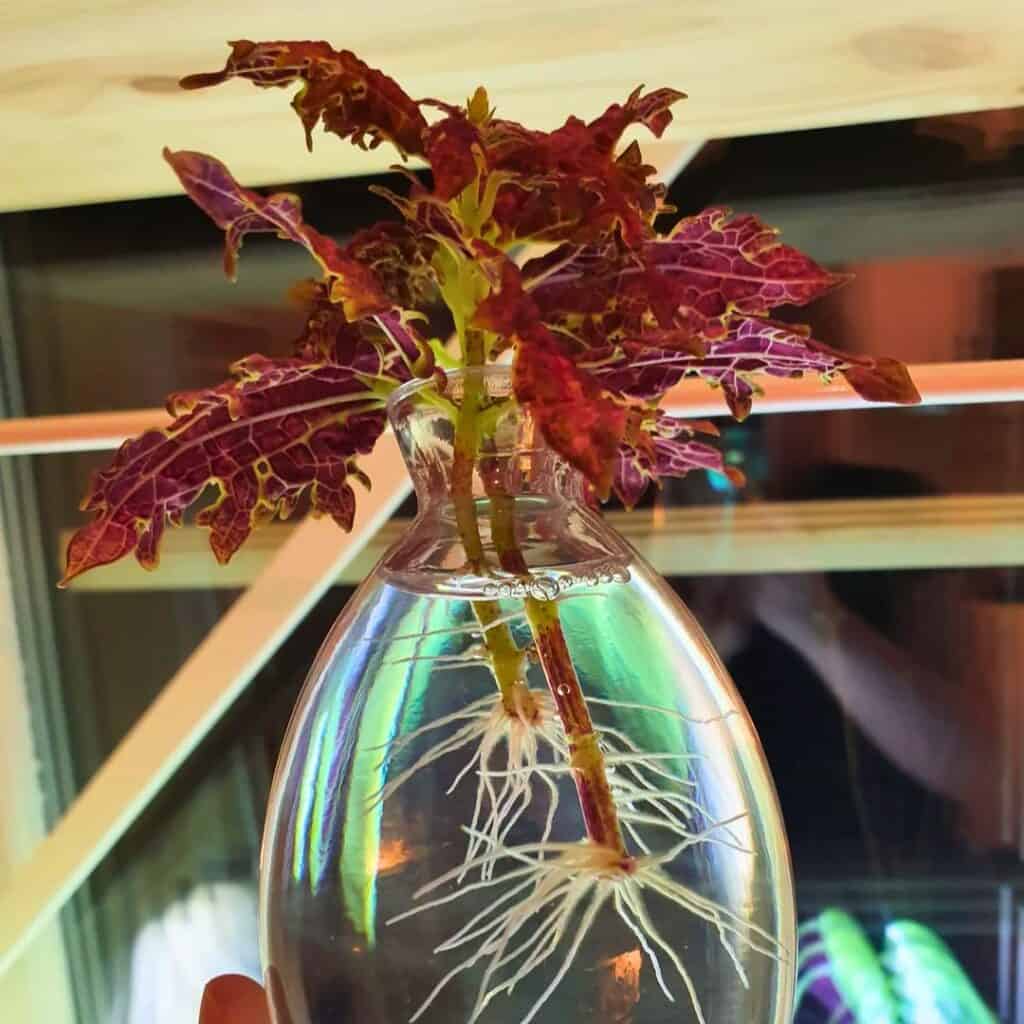
I just love how Coleus instantly brightens up a room. The leaves are wild—reds, greens, pinks, yellows—sometimes all at once.
To get started, I usually snip a 4- to 6-inch stem just below a leaf node. I pull off the lower leaves so they don’t end up sitting in the water.
Then I pop the cutting into a clear glass jar with some clean, room-temperature water. It’s really that simple.
I always keep the jar in bright, indirect light. If it’s too sunny, the leaves can fade or even get scorched.
Within a week or two, I’ll spot tiny roots starting to show. That’s when I know it’s working.
I try to swap out the water every few days. It just keeps things fresh and helps avoid any weird smells or bacteria.
Once those roots reach about two inches, the plant looks pretty happy and healthy. It’s a satisfying little project.
What’s really nice about Coleus is how easy it is to propagate. I can just cut another stem and start over again, almost without thinking.
If I want the plant to grow bushier, I pinch off the tips of new shoots. That stops it from getting leggy and keeps things looking full.
Coleus likes room temperatures—somewhere between 65°F and 75°F is perfect. I try not to put it near cold drafts or blasting heat vents.
As long as it gets enough light and fresh water, those colorful leaves stay nice and vibrant. It’s such an easy way to liven up a desk or windowsill.
Honestly, growing Coleus in water is about as low-maintenance as it gets. It’s a fun, no-fuss plant if you want a bit of color without dealing with dirt.
10) Heartleaf Philodendron

I have to say, the Heartleaf Philodendron is one of the easiest plants I’ve ever kept in water. Those glossy, heart-shaped leaves look so good trailing out of a glass jar.
To start, I cut a 4–6 inch stem just below a leaf node. I strip off the bottom leaves and stick the stem in a clear glass of water.
I always make sure the nodes are underwater—that’s where the new roots show up. It’s a detail that makes all the difference.
I set the glass somewhere with bright, indirect light. Too much sun can burn the leaves, but if it’s too dark, the plant barely grows.
Every week or so, I swap out the water to keep things fresh. It really helps prevent any gunk from building up.
After a couple weeks, I usually spot small white roots poking out. Once those roots are a few inches long, the plant just keeps going.
Sometimes I’ll add a drop of liquid fertilizer once a month. Not always, but it seems to help.
What I love most is how easily it fits into small spaces. I can put it on my desk, a shelf, or even the windowsill, and it still looks lush.
The vines can get pretty long, so I trim them back now and then to keep things tidy. It’s easy to shape.
This plant even helps clean the air a bit, which is a nice bonus. If you want some greenery without the mess, it’s a great choice.
The Heartleaf Philodendron stays green all year and doesn’t ask for much. As long as the water’s clean and it gets some light, it just keeps growing.
11) Swedish Ivy

I’m a big fan of Swedish Ivy—it just grows so fast and always looks fresh. Those round, glossy leaves trailing from a jar really brighten up any little corner.
I usually grab a few cuttings with at least one node and stick them in a glass of clean water. In a week or two, roots start popping out.
No fancy tools, no soil, just water and patience. That’s my kind of plant.
I keep my jar near a bright window, but not in direct sun. Too much light can burn the leaves, but if it’s too dark, the growth slows down.
Swedish Ivy likes steady, moderate light best. It’s not too picky, which I appreciate.
I change the water every few days to keep it clear. That way, there’s no weird smell or algae building up.
Once the roots get longer, I can leave the plant in water or move it to soil if I’m feeling ambitious.
One thing I really enjoy is how easy it is to share Swedish Ivy. I just cut a few stems, root them in water, and give them away once they’ve got roots.
It’s a simple way to spread some green and make someone’s day a little brighter.
The soft, trailing stems look great in hanging jars or bottles. I like using clear glass so I can watch the roots grow.
It adds a subtle touch of nature to my kitchen or desk. It’s kind of relaxing to see.
Swedish Ivy doesn’t need much fertilizer, but every now and then I’ll add a drop of liquid plant food—maybe once a month.
It keeps the leaves shiny and healthy. The plant seems to appreciate the occasional treat.
I trim the stems when they get too long. That keeps things tidy and encourages new growth.
The cuttings can go right back into water to start over. It’s a never-ending cycle, in a good way.
If the leaves droop, I usually just check the light and water. A quick fix and it bounces back.
Swedish Ivy is forgiving, which is great if you’re just starting out or forgetful like me.
It’s low-maintenance and decorative—a little green life without much fuss.
12) Watermelon Peperomia

Growing Watermelon Peperomia in water is honestly so easy. Those leaves really do look like tiny watermelons, which always makes me smile.
It’s a small, tidy plant—perfect for desks or shelves if you don’t have much space.
To get started, I cut a healthy stem with at least one leaf and put it in a glass of clean water.
I make sure the leaf isn’t touching the water, just to avoid any rot. The plant seems to like bright, indirect light and a cozy spot.
I change the water every week, just out of habit. When I spot new roots forming, I know it’s happy.
Usually, roots show up in a few weeks if the light and temperature are decent.
This plant doesn’t really need fertilizer in water, but sometimes I’ll add a tiny drop of liquid plant food once a month.
It helps keep the leaves looking bright and healthy. Not a must, but I like to spoil it a little.
I also like how easy it is to move around. A small jar or bottle works, and it actually looks cool in clear glass.
Watching the roots grow is weirdly satisfying. It adds a bit of nature to my space.
Watermelon Peperomia grows slowly, so there’s not much trimming involved. If it gets too tall, I just cut a new stem and start again.
It’s a fun way to share plants with friends, too.
I’ve noticed it does best in room temperature water and out of direct sun. Too much heat or strong light can make the leaves fade.
Growing it in water means no soil spills or mess. If you want something simple and fresh, this plant is a great pick.
13) Tradescantia

Tradescantia—also called wandering Jew or inch plant—is just so easy to grow. The leaves are colorful, and I think they make any windowsill look a bit happier.
I like that I can grow it in water and skip the soil altogether.
To start, I cut a 4–6 inch stem just below a leaf node. I strip off the lower leaves and put the cutting in a glass jar with clean water.
Usually, I spot small roots forming within a week or two. It’s always a nice surprise.
I keep the jar in a bright spot with indirect sunlight. Direct sun can fade the colors, so I try to avoid that.
I change the water every few days to keep it fresh and clear. The plant seems to appreciate it.
Once the roots are a few inches long, Tradescantia just keeps growing in water. I’ll add a drop of liquid fertilizer once a month if I remember.
What’s really great is how easily it multiplies. When stems get long, I trim them and start new cuttings.
It’s a simple way to share plants or fill more jars around the house.
Tradescantia grows fast, so I trim it often to keep it looking full. The new growth keeps things lush and colorful.
I like mixing different varieties in one container. Some have purple leaves, others are green with silver or pink stripes.
The combination looks really good and adds some variety to my space.
Watching Tradescantia grow in water is a reminder that indoor gardening doesn’t have to be complicated. It’s a low-maintenance way to enjoy some greenery without any dirt.
14) Nerve Plant

The Nerve Plant (Fittonia) is one of my favorites for adding a splash of color. Its little leaves have these bright veins—pink, white, or red—that look so lively, even if you just stick them in a glass of water.
To get it going, I snip a few healthy stems just below a leaf node. I toss them in a jar with clean, room-temperature water, making sure the leaves don’t touch the water so they won’t rot.
I keep the jar somewhere with bright, indirect light. Direct sun is a no-go; those leaves scorch easily.
Every week or so, I swap out the water to keep things fresh and avoid any gross bacteria buildup.
After a couple of weeks, I usually spot new roots starting to poke out. Once they’re about an inch long, the plant can stay in water for ages, as long as I keep the water clean and the light just right.
The Nerve Plant prefers warm, humid air, so I’ll mist the leaves now and then. If the edges curl or brown, it’s probably too dry in the room.
Watching this plant grow feels rewarding because it’s honestly so easy. Its bold veins and compact size make it perfect for desks, shelves, or little jars—it’s cheerful, doesn’t need soil, and barely asks for anything.
15) Chinese Money Plant
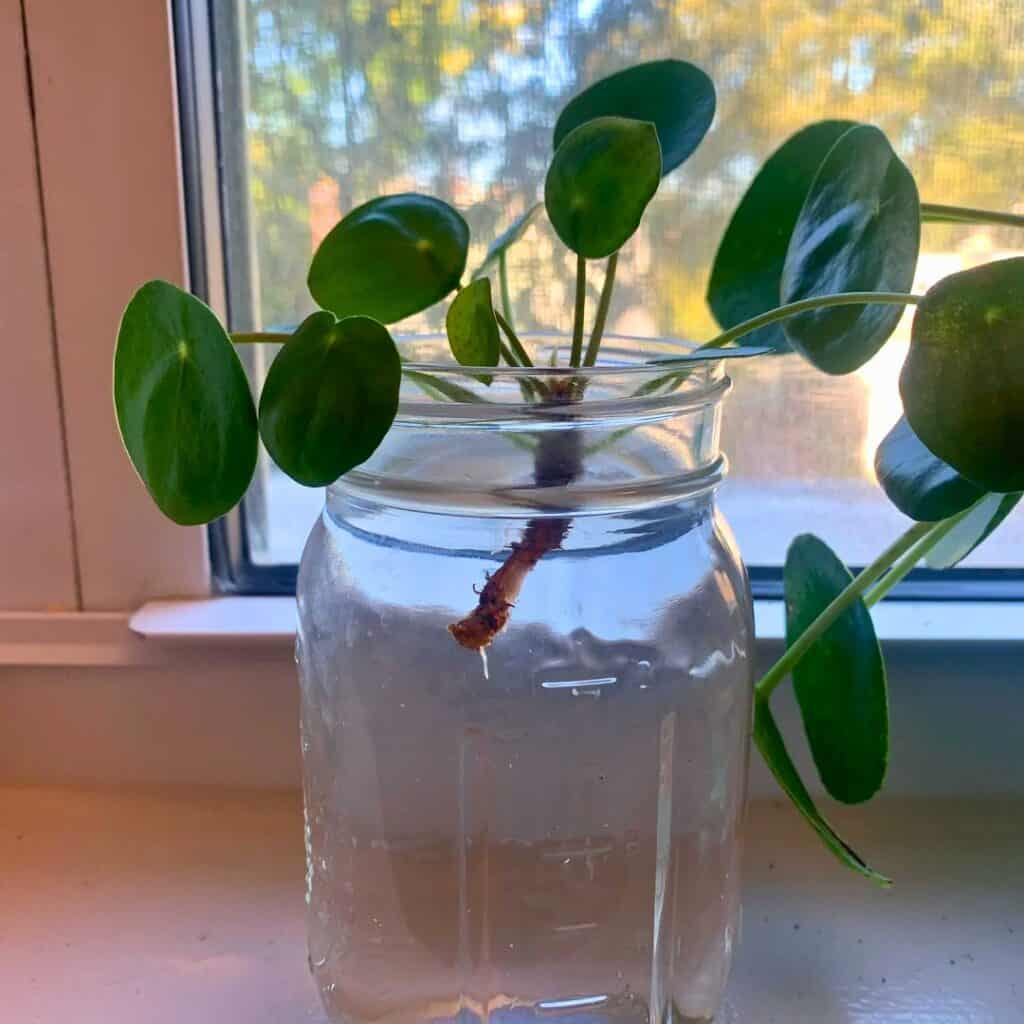
The Chinese Money Plant is such a breeze to grow in water. Those round, coin-like leaves look modern and quirky, and I love having one on my windowsill.
No soil needed, which keeps things tidy and simple. I just cut a healthy stem with a few leaves and drop it in a glass jar of clean water, making sure the nodes are under the surface.
Roots usually show up in a couple of weeks, which always feels a bit magical.
I swap out the water every week to keep it clear and avoid algae. Filtered or room-temp water is best—tap water sometimes slows things down.
The Chinese Money Plant likes bright, indirect light. I keep mine near a sunny window but not in direct sun, since the leaves burn easily.
If the leaves droop, I’ll move it to a brighter spot or just refresh the water.
Once the roots are a few inches long, it’s happy to live in water for months. Sometimes I add a drop of liquid fertilizer every few weeks if it needs a little pick-me-up.
It’s actually a fun plant to share. I often snip a cutting, pop it in a jar, and give it to a friend—such an easy way to spread some green around.
16) Jade Plant Cuttings

I’m always amazed how jade plants can grow from just a cutting. These tough little succulents make it easy to start new plants without any soil.
All it takes is a healthy stem, some water, and a bit of patience. I cut a 3- to 4-inch piece from a mature jade, making sure it’s got a few leaves.
I strip the lower leaves so the stem can sit in water without rotting. Before putting it in water, I let the cutting dry for a day or two so it forms a callus—that seems to really help prevent rot.
Then I stick the stem in a small glass of clean water, just enough to cover the bottom inch. I set it somewhere with bright, indirect light, but not direct sun.
I change the water every few days, just to keep things fresh. After a couple of weeks, I usually spot tiny roots starting to grow.
Once those roots hit about an inch, I can leave the plant in water or move it to soil for faster growth. Either way, it’s satisfying to see a new jade plant start from almost nothing.
Jade plant cuttings are honestly one of the easiest ways to multiply this houseplant. No fancy tools or soil needed—just a little attention and patience. I get a kick out of how simple and rewarding it is.
17) Mint

Growing mint in water is probably the easiest herb project I’ve tried. It grows fast, smells great, and I never have to mess with soil—just a few healthy stems and a clean jar.
I cut a 4-6 inch stem from a healthy mint plant and take off the lower leaves so they don’t sit in the water. The stem goes right into a jar of room-temperature water.
I keep it near a bright window but out of direct sun, since too much heat makes the leaves wilt. Every few days, I change the water to keep it clear.
In a week or two, I usually see small white roots popping out along the stem. Once the roots are about an inch long, the plant settles in and starts making new leaves.
I like to pinch the tips often to keep it bushy instead of tall and leggy.
Mint prefers cool, clean water. I let tap water sit out overnight to get rid of chlorine before using it.
Fresh mint leaves are perfect for tea, lemonade, and salads. The flavor stays strong, and as long as I keep the water fresh, the plant keeps producing.
If the roots get crowded, I just move a few stems to another jar. That way, they don’t suffocate and the water stays clear.
Growing mint this way is honestly so easy and satisfying. It saves space, smells amazing, and gives me fresh herbs right on my counter.
18) Basil
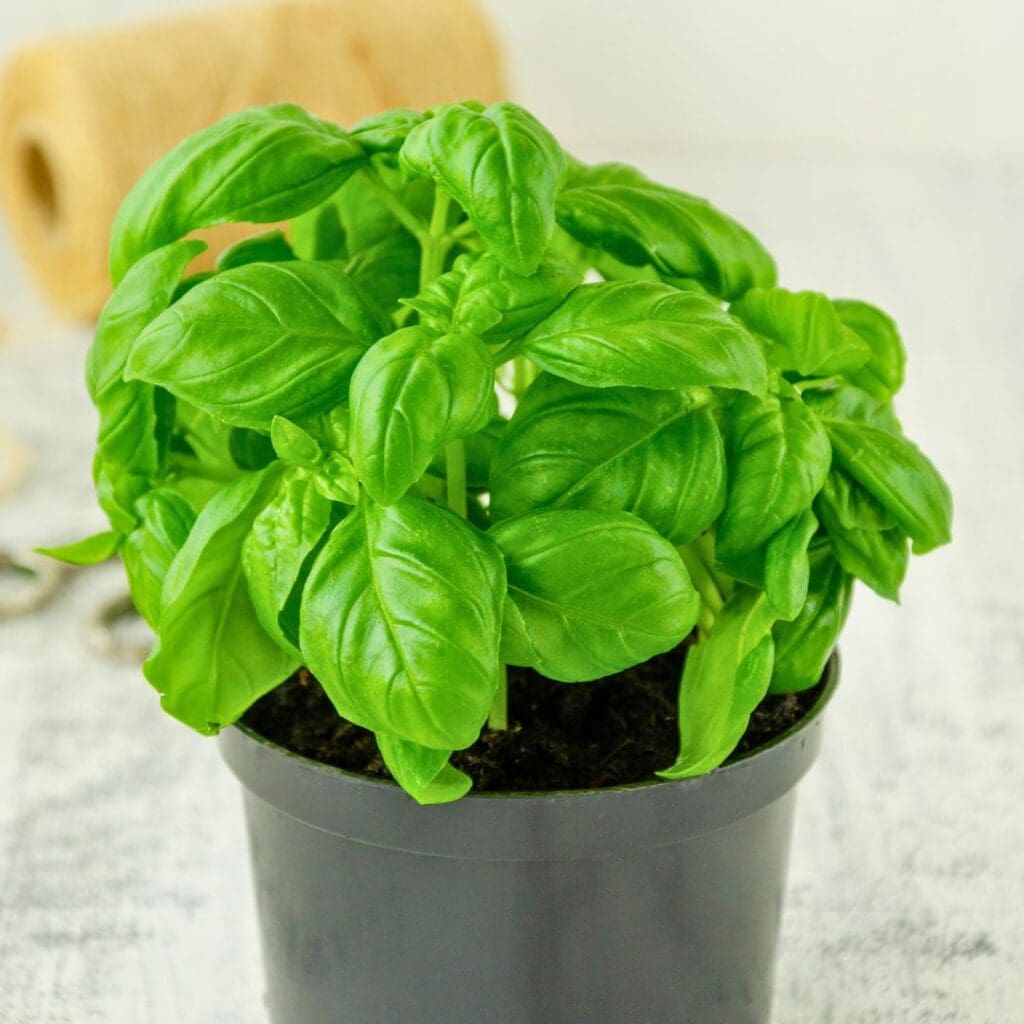
Basil is another herb that’s super easy to grow in water. I just grab a few healthy cuttings from a mature plant and pop them in a glass of water.
Roots usually show up within a week or two, which is always fun to see. I keep the glass in a bright spot with indirect sun—direct sunlight can overheat the water and damage the roots.
Changing the water every few days keeps it fresh and stops any bacteria from taking over.
Once the roots are a few inches long, basil does fine in water. I trim the leaves often to keep it growing and prevent it from getting too tall.
Sometimes I’ll add a tiny drop of liquid fertilizer if the leaves look pale, just to give it a boost.
Nothing beats fresh basil in pasta, salads, or sauces. It’s so handy to just pick fresh herbs right from the windowsill.
Basil likes warm temperatures and hates cold drafts, so I keep it away from vents or chilly windows.
Growing basil in water saves space and fills the kitchen with that classic scent. It’s honestly one of the easiest herbs to care for, and I always have some on hand for cooking.
19) Lemon Balm

Lemon balm is such a cheerful plant to grow in water. It’s easy and the fresh, citrusy scent makes my kitchen feel brighter.
To start, I snip a few healthy cuttings with several leaves and a couple inches of stem. I drop them in a glass jar of clean water, making sure the leaves don’t touch the water.
I set the jar in a sunny window with bright, indirect light. Every few days, I change the water so it stays clear.
Roots usually show up within a week or two. When they’re an inch or two long, the lemon balm keeps growing happily in water.
Trimming the stems now and then encourages bushier growth, and the leaves stay green and fragrant with enough light.
I use the leaves in tea, salads, and homemade infusions. The lemony flavor is subtle and refreshing, and sometimes I just crush a leaf to freshen the air.
Lemon balm doesn’t need much—just clean water and light. If the leaves start to yellow, I rinse the jar and refill it.
It’s also really easy to share. When friends visit, I’ll clip a few stems and show them how to root their own.
Watching lemon balm grow in water is a nice reminder that plants don’t always need soil. It’s a small, happy plant that fits perfectly on a desk or kitchen counter.
How to Grow Plants in Water
Growing plants in water is honestly simple once you’ve got the right container, clean water, and decent light. Each part matters if you want healthy roots and steady growth.
Choosing the Right Container
I always pick a container that fits the plant’s size. Glass jars, vases, or bottles are my go-tos because I can see the roots and water level. Metal containers? Not for me—they can rust and hurt the plant.
For plants with long stems, like pothos, I like narrow-necked containers. Bushier plants like mint do better in something with a wide opening so they’re not cramped.
Keeping the container clean is a must. I wash it every couple of weeks with mild soap and rinse it really well.
Sometimes I’ll toss in decorative pebbles or glass beads at the bottom—mostly because it looks nicer and helps support the stems.
| Container Type | Best For | Notes |
|---|---|---|
| Glass jar | Most small plants | Easy to clean |
| Vase | Long-stem plants | Good light exposure |
| Bottle | Cuttings | Keeps stems upright |
Best Water Types for Healthy Growth
I’ve noticed that clean, chlorine-free water makes a huge difference. Tap water works if I let it sit out for a day so the chlorine can evaporate. Filtered or rainwater is even better—roots seem to love it.
I change the water every 7 to 10 days to keep things fresh and full of oxygen. If water sits too long, it can smell or cause root rot.
A drop of liquid fertilizer once a month helps plants get nutrients they’d normally pull from soil. I’m careful not to overdo it—roots are sensitive.
Cloudy water or algae is my cue to rinse the container and refill it. Clear water is always better for roots.
Lighting and Location Tips
I put my water-grown plants in bright, indirect light. Direct sun can heat up the water and hurt roots, especially in glass.
If the room’s a bit dim, I’ll use a small grow light for a few hours a day. It helps keep plants like basil or coleus looking good.
I make sure the spot isn’t drafty or too cold. Stable temperatures—around 65°F to 75°F—seem to work best.
Every week, I rotate the container so all sides get some light. That way, the plant doesn’t lean too much and grows more evenly.
Caring for Your Water-Grown Plants
I keep my water-grown plants healthy by giving them clean water and the right nutrients. I watch for algae and change the water often to keep the roots happy and strong.
Changing Water and Preventing Algae
I change the water every 7–10 days—it’s just easier to stay ahead of bacteria and algae that way. When I refill the container, I give it a quick rinse with mild soap and warm water, then let it dry before pouring in fresh water.
This little routine really helps keep the roots clean and avoids that gross, slimy mess nobody wants.
I stick with filtered or dechlorinated water since chlorine isn’t great for roots. If I’m using regular tap water, I just let it sit out for a day so the chlorine can fade away on its own.
To keep algae at bay, I make sure jars or vases are out of direct sunlight. Whenever I can, I’ll use dark or opaque containers—algae just can’t thrive without light.
If I still spot some algae, I’ll scrub out the container and rinse the roots before putting the plant back in clean water. Dropping a bit of activated charcoal at the bottom of the jar helps keep things clearer, too.
Nutrient Solutions for Thriving Plants
Water’s not enough on its own, so every few weeks I add a liquid fertilizer. I usually go for a formula made for hydroponic plants, or just mix in a couple drops of all-purpose plant food.
I always stick to the label directions—too much fertilizer can burn the roots, and nobody wants that. If I see slow growth or pale leaves, it’s usually a sign the plant’s hungry.
Here’s a quick guide I use:
| Plant Type | Feeding Frequency | Notes |
|---|---|---|
| Herbs (mint, basil) | Every 2 weeks | Use half-strength solution |
| Houseplants (pothos, philodendron) | Monthly | Change water after feeding |
| Succulent cuttings | Rarely | Feed only after roots form |
I keep an eye on how each plant reacts and tweak things if I need to. Plants have personalities, don’t they?
Frequently Asked Questions
What are some easy-to-grow water plants for beginners?
Honestly, I’d start with Pothos, Lucky Bamboo, or Spider Plant. They’re super forgiving, happy in jars or vases, and don’t demand much fuss.
How often should I change the water for my hydroponic plants?
I go for every one to two weeks. It keeps things fresh and helps avoid any weird smells or algae. If the water starts looking cloudy, I just swap it out sooner.
Can you suggest any flowering plants that thrive in water alone?
Peace Lily and Begonia can bloom in water if they get enough light. I keep them near a bright window, but not right in the sun.
What nutrients do I need to add to the water for healthy plant growth?
I use a liquid fertilizer made for hydroponics, or sometimes just a few drops of houseplant fertilizer diluted in water. That seems to keep my plants green and happy.
How can I prevent algae growth in my water-based plant containers?
I stick with dark or opaque containers to block out the light, and I always clean the glass before refilling. Keeping the setup out of direct sunlight really helps, too.
Are there any edible plants that can be grown in water without soil?
Absolutely! I keep green onions, basil, and mint thriving in jars of water right on my kitchen counter.
They’re fast growers and honestly, it’s pretty satisfying to snip off fresh herbs whenever I need a little burst of flavor.
Recommended Garden Supplies
| Product Image | Our Recommended Gardening Supplies | Check Offers! |
|---|---|---|
Top Top
Top
Top
Top
Top
Top
Top
Top | rePotme Houseplant and Tropical Classic Potting Soil Mix | Check Offer On Amazon |
 Top
Top
Top
Top
Top
Top
Top
Top | Espoma Organic Indoor Plant Food | Check Offer On Amazon |
 Top
Top
Top
Top
Top
Top
Top
Top | GooingTop LED Grow Light 6000K Full Spectrum Clip Plant Growing Lamp | Check Offer On Amazon |
 Top
Top
Top
Top
Top
Top
Top
Top | Soil Moisture Meter | Check Offer On Amazon |
 Top
Top
Top
Top
Top
Top
Top
Top | Govee Hygrometer Thermometer, Bluetooth Enabled! | Check Offer On Amazon |
 Top
Top | LEVOIT Humidifiers for Large Room(Best For Plants) | Check Offer On Amazon |
 Top
Top
Top
Top
Top
Top
Top
Top | Upgraded DIY Automatic Drip Irrigation Kit, 15 Potted Houseplants Support | Check Offer On Amazon |
 Top
Top
Top
Top
Top
Top
Top
Top | Stainless Steel Heavy Duty Gardening Tool Set | Check Offer On Amazon |
 Top
Top
Top
Top
Top
Top
Top
Top | Bonide Insecticidal Soap | Check Offer On Amazon |
 Top
Top
Top
Top
Top
Top
Top
Top | Bonide 32 oz Spray Neem Oil for Organic Gardening | Check Offer On Amazon |
 Top
Top
Top
Top
Top
Top
Top
Top | Garden Safe Fungicide | Check Offer On Amazon |
Note: Some images in the articles are sourced from Reddit and Other Platforms For Reference Purpose.

